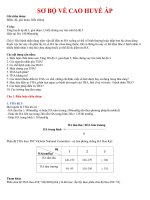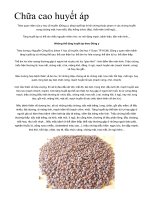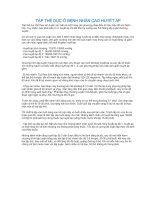Pulmonary hypertension cao huyết áp
Bạn đang xem bản rút gọn của tài liệu. Xem và tải ngay bản đầy đủ của tài liệu tại đây (3.04 MB, 80 trang )
<span class="text_page_counter">Trang 2</span><div class="page_container" data-page="2">
SOURCES
<small>ESC 2015 PH </small>
<small>Simonneau G, Montani D, Celermajer DS, et al. Haemodynamic </small>
<small>definitions and updated clinical classification of pulmonary hypertension. Eur Respir J 2019; 53: 1801913. </small>
<small>Pulmonary Arterial Hypertension in 2019: From death sentence to chronic disease Trushil Shah, M.D. </small>
<small>Galiè N, McLaughlin VV, Rubin LJ, et al. An overview of the 6th World Symposium on Pulmonary Hypertension. Eur Respir J 2018. </small>
<small>2019 up to date Clinical features and diagnosis of pulmonary hypertension of unclear etiology in adults. </small>
<small>2019 up to date Treatment of pulmonary hypertension in adults. </small>
<small>2019 up to date Prognosis of pulmonary hypertension in adults </small>
</div><span class="text_page_counter">Trang 6</span><div class="page_container" data-page="6">BỆNH ÁN
<small>Tiền căn: thông liên nhĩ 1 năm nay, đang điều trị với Bosentan, và Ditilazem. Bệnh sử: cách nhập viện Chợ Rẫy 1 ngày, bệnh nhân nhập viện sản Từ Dũ với chẩn đoán : con so, thai 29 tuần 2 ngày, thai chậm tăng trưởng, thiểu ối – Thông liên nhĩ, shunt 2 chiều, tăng áp động mạch phổi nặng được chỉ định mổ lấy thai ở bệnh viện Từ Dũ. </small>
<small>Sau mổ gây tê ngoài màng cứng, bệnh nhân cảm giác mệt và khó thở. Huyết áp 120/80mmHg, mạch: 114 lần/phút, nhịp thở: 30 lần/phút, SpO2: 62%, nhịp tim đều, phổi trong, bụng mềm, vết thương mổ khô, tử cung gò khá. Điều trị: Augbidil 1,2g – 3 lọ/ngày → bệnh viện Chợ Rẫy điều trị tiếp. </small>
</div><span class="text_page_counter">Trang 7</span><div class="page_container" data-page="7">BỆNH ÁN
<small>TTPT MỔ LẤY THAI (12h20 ngày 28 tháng 5 năm 2019) </small>
<small>Phương pháp phẫu thuật: phẫu thuật ngang đoạn dưới tử cung lấy thai lần đầu Phương pháp vô cảm: gây tê màng cứng </small>
<small>Rạch da, bóc tách phúc mạc đoạn dưới tử cung, rạch mổ ngang đoạn dưới tử </small>
</div><span class="text_page_counter">Trang 8</span><div class="page_container" data-page="8"><small>Đường huyết mao mạch: 41mg/dl </small>
<small>Xử trí: thở mask 10l/p, NaCl 0.9% 1 chai giữ vein, Glucose 20% 250 1 chai TTM XX g/p </small>
<small> chuyển Nội Tim Mạch điều trị </small>
</div><span class="text_page_counter">Trang 9</span><div class="page_container" data-page="9">BỆNH ÁN
<small></small> Bệnh nhân tỉnh, tiếp xúc được
SpO2 : 65%
<small></small> Than mệt, khó thở, không ho, không sốt
<small></small> Chi ấm, niêm hồng, mạch rõ, tím đầu chi, ngón tay dùi trống
<small></small> Tim đều rõ, phổi trong, bụng mềm, phù nhẹ 2 chi dưới.
</div><span class="text_page_counter">Trang 10</span><div class="page_container" data-page="10">BỆNH ÁN
<small></small> Siêu âm Doppler tim:
<small>Dãn buồng tim phải. TAPSE = 12mm. </small>
<small>Chức năng co bóp trong giới hạn bình thường EF = 74% (pp Teicholz). </small>
<small>Thơng liên nhĩ lỗ thứ phát d = 23mm, shunt phải trái. </small>
<small>Tăng áp động mạch phổi nặng PAPs = 116mmHg. </small>
</div><span class="text_page_counter">Trang 11</span><div class="page_container" data-page="11">BỆNH ÁN
</div><span class="text_page_counter">Trang 12</span><div class="page_container" data-page="12">BỆNH ÁN
<small>12:26 BUN : 30 mg/dL, creatinine: 1.58 mg/dL. eGFR: 43.76 mL/phút/1.73 m2 da. Na: 133 mmol/L, K 7.0 </small>
<small>mmol/L, Cl 104 mmol/L. </small>
<small>17:03 BUN : 29 mg/dL, creatinine: 1.55 mg/dL. eGFR: 44.78 mL/phút/1.73 m2 da. Na: 133 mmol/L, K 5.3 </small>
<small>mmol/L, Cl 105 mmol/L. </small>
<small>AST/ALT: 59/27 U/L. Troponin I: 0.697 ng/mL </small>
</div><span class="text_page_counter">Trang 14</span><div class="page_container" data-page="14">BỆNH ÁN
</div><span class="text_page_counter">Trang 15</span><div class="page_container" data-page="15"><small>Chẩn đốn tại 7b3: Thơng liên nhĩ shunt P – T (đã đảo shunt) – Suy thất Phải – Tăng áp động mạch phổi – Suy thận cấp – Hậu phẫu mổ bắt con so ngày 2 </small>
<small>Điều trị: </small>
<small>Thở oxy mask 10l /p </small>
<small>Herbesser 60mg 1/2 v (uống) Bosentan 125mg 1 v (uống) </small>
</div><span class="text_page_counter">Trang 17</span><div class="page_container" data-page="17"><small>Theo dõi sát sinh hiệu Đặt sonde tiểu lưu </small>
</div><span class="text_page_counter">Trang 20</span><div class="page_container" data-page="20">DEFINE
Hypertension (WSPH) (mPAP) ≥ 25 mm Hg.
<small></small> 2009, Kovacs et. al. performed a systematic review on right heart catheterization (RHC) data on 1187 individuals: normal mPAP 14 ― 3.3 mm Hg → mPAP rarely > 20 mm Hg (97.5<sup>th</sup> %).
<small>PH - mPAP > 20 mm Hg. </small>
</div><span class="text_page_counter">Trang 21</span><div class="page_container" data-page="21">Vascular Pressure in Systemic and
</div><span class="text_page_counter">Trang 22</span><div class="page_container" data-page="22">PH: The Importance of Hemodynamics
<b><small> Pulmonary venous hypertension </small></b>
</div><span class="text_page_counter">Trang 23</span><div class="page_container" data-page="23">HAEMODYNAMIC DEFINITIONS
</div><span class="text_page_counter">Trang 24</span><div class="page_container" data-page="24">HAEMODYNAMIC DEFINITIONS
<b><small>SOURCES HAEMODYNAMIC DEFINITIONS</small></b>
<b><small>Pulmonary Arterial Hypertension (PAH) </small></b>
<small>(PCWP) ≤ 15 mm Hg and </small>
<small>Pulmonary vascular resistance > 3 </small>
<b><small>Pulmonary hypertension due to left heart disease </small></b>
<small>(PCWP) > 15 mm Hg </small>
<b><small>Pulmonary hypertension due to lung disease and/or hypoxia </small></b>
<small>(PCWP) ≤ 15 mm Hg and </small>
<small>concomitant lung disease and/or hypoxia </small>
<b><small>Pulmonary hypertension due to pulmonary artery obstructions </small></b>
<small>(PCWP) ≤ 15 mm Hg and </small>
<small>an entity causing pulmonary artery obstruction </small>
<b><small>Pulmonary hypertension with unclear and/or multifactorial mechanisms </small></b>
<small>multifactorial mechanisms or </small>
<small>unclear underlying pathophysiological mechanisms </small>
</div><span class="text_page_counter">Trang 29</span><div class="page_container" data-page="29">Cause of death
<small></small> right heart failure with circulatory collapse and superimposed respiratory failure.
<small>6% survived > 90 days. </small>
</div><span class="text_page_counter">Trang 30</span><div class="page_container" data-page="30">Acute decompensated pulmonary hypertension
<small></small> Sudden worsening of clinical signs of right heart failure with subsequent systemic circulatory
insufficiency and multisystem organ failure. <small></small> In-hospital mortality: 14% to 100%.
<i><small>1. Haddad F, Peterson T, Fuh E , et al. Characteristics and outcome after hospitalization for acute right heart failure in patients with pulmonary arterial </small></i>
<i><small>hypertension. Circ Heart Fail 2011; 4: 692–699. </small></i>
<i><small>2. Jiang R, Ai Z-S, Jiang X, et al. Intravenous fasudil improves in-hospital mortality of patients with right heart failure in severe pulmonary </small></i>
<i><small>hypertension. Hypertens Res 2015; 38: 539–544. </small></i>
</div><span class="text_page_counter">Trang 31</span><div class="page_container" data-page="31">Gradual evolution towards end-stage pulmonary
hypertension.
<b><small>Laurent Savale et al. Eur Respir Rev 2017;26:170092 </small></b>
<small>©2017 by European Respiratory Society </small>
</div><span class="text_page_counter">Trang 34</span><div class="page_container" data-page="34">CLINICAL PRESENTATION
20% patients severe-serious symptoms : 2 years. <small></small> Dyspnea and fatigue.
<small></small> Symptoms of right ventricular (RV) : •Exertional chest pain.
•Exertional syncope.
•Weight gain from edema.
•Anorexia and/or abdominal pain and swelling
<small>Brown LM, Chen H, Halpern S, et al. Delay in recognition of pulmonary arterial hypertension: factors identified from the REVEAL Registry. Chest 2011; 140:19.</small>
</div><span class="text_page_counter">Trang 35</span><div class="page_container" data-page="35"><b><small>New York Heart Association functional classification </small></b>
<b><small>Class 1 </small></b> <small>No symptoms with ordinary physical activity. </small>
<b><small>Class 2 </small></b> <small>Symptoms with ordinary activity. Slight limitation of activity. </small>
<b><small>Class 3 </small></b> <small>Symptoms with less than ordinary activity. Marked limitation of activity. </small>
<b><small>Class 4 </small></b> <small>Symptoms with any activity or even at rest. </small>
<b><small>World Health Organization functional assessment classification </small></b>
<b><small>Class I </small></b> <small>Patients with PH but without resulting limitation of physical activity. Ordinary </small>
<small>physical activity does not cause undue dyspnea or fatigue, chest pain, or near syncope. </small>
<b><small>Class II </small></b> <small>Patients with PH resulting in slight limitation of physical activity. They are </small>
<small>comfortable at rest. Ordinary physical activity causes undue dyspnea or fatigue, chest pain, or near syncope. </small>
<b><small>Class III </small></b> <small>Patients with PH resulting in marked limitation of physical activity. They are </small>
<small>comfortable at rest. Less than ordinary activity causes undue dyspnea or fatigue, chest pain, or near syncope. </small>
<b><small>Class IV </small></b> <small>Patients with PH with inability to carry out any physical activity without symptoms. These patients manifest signs of right-heart failure. Dyspnea and/or fatigue may even be present at rest. Discomfort is increased by any physical activity. </small>
</div><span class="text_page_counter">Trang 36</span><div class="page_container" data-page="36">Signs on examination
<small></small> <sub>Jugular venous pressure (JVP) abnormalities. </sub> <small>Right-sided auscultatory: </small>
<small>-A right-sided third or fourth heart sound (ie, a gallop) in association with a left parasternal heave or a downward </small>
<small>subxiphoid thrust. </small>
<small>-Wide splitting of the second heart sound. </small>
<small>-A holosystolic murmur of tricuspid regurgitation, </small>
<small>diastolic pulmonic systolic ejection murmur, diastolic pulmonic regurgitation murmur. </small>
<small>Hepatomegaly, a pulsatile or tender liver, peripheral edema, ascites, and pleural effusion, splenomegaly </small>
</div><span class="text_page_counter">Trang 37</span><div class="page_container" data-page="37">Imaging
Chest x-ray:
</div><span class="text_page_counter">Trang 38</span><div class="page_container" data-page="38">Imaging
Chest CT scan:
</div><span class="text_page_counter">Trang 39</span><div class="page_container" data-page="39">Imaging
Chest CT scan:
</div><span class="text_page_counter">Trang 40</span><div class="page_container" data-page="40">Imaging
ECG
</div><span class="text_page_counter">Trang 41</span><div class="page_container" data-page="41">Imaging
<b><small>Echocardiographic probability of pulmonary hypertension in symptomatic patients with a suspicion of pulmonary hypertension </small></b>
<small>≤2.8 or not measurable No Low ≤2.8 or not measurable Yes </small>
</div><span class="text_page_counter">Trang 42</span><div class="page_container" data-page="42">Imaging
<b><small>Echocardiographic signs suggesting pulmonary hypertension used to assess the probability of pulmonary hypertension in addition to tricuspid regurgitation velocity measurement in Table A </small></b>
<b><small>A: The ventricles¶B: Pulmonary artery¶C: Inferior vena cava and right atrium¶</small></b>
<small>Right ventricle/left ventricle basal diameter ratio >1.0 </small>
<small>Right ventricular outflow </small>
<small>Doppler acceleration time <105 msec and/or midsystolic </small>
<small>notching </small>
<small>Inferior cava diameter >21 mm with decreased inspiratory collapse (<50% with a sniff or <20% with quiet inspiration) </small>
<small>Flattening of the interventricular septum (left ventricular </small>
<small>eccentricity index >1.1 in systole </small>
</div><span class="text_page_counter">Trang 43</span><div class="page_container" data-page="43">Imaging
</div><span class="text_page_counter">Trang 44</span><div class="page_container" data-page="44">Imaging video
</div><span class="text_page_counter">Trang 45</span><div class="page_container" data-page="45">Risk assessment
pulmonary arterial hypertension
</div><span class="text_page_counter">Trang 48</span><div class="page_container" data-page="48">Diagnostic algorithm
</div><span class="text_page_counter">Trang 51</span><div class="page_container" data-page="51">DIAGNOSIS PH
Conclusions: DE estimates of PASP are inaccurate in patients with PH and should not be relied on to make the
diagnosis of PH or to follow the efficacy of therapy. CHEST 2011; 139(5):988–993
</div><span class="text_page_counter">Trang 52</span><div class="page_container" data-page="52">DIAGNOSIS PH
</div><span class="text_page_counter">Trang 53</span><div class="page_container" data-page="53">Classification 5 groups PH
<b><small>1 </small></b> <small>PAP </small>
<b><small>2 </small></b> <small>PH due to left heart disease </small>
<b><small>3 </small></b> <small>PH due to chronic lung disease and/or hypoxemia </small>
<b><small>4 </small></b> <small>PH due to pulmonary artery obstructions </small>
<b><small>5 </small></b> <small>PH due to multifactorial mechanisms </small>
</div><span class="text_page_counter">Trang 54</span><div class="page_container" data-page="54">Risk assessment
pulmonary arterial hypertension
</div><span class="text_page_counter">Trang 58</span><div class="page_container" data-page="58"><small></small> The use of angiotensin-converting enzyme inhibitors, angiotensin-2 receptor antagonists, beta-blockers and ivabradine <b>is not recommended </b>in patients with PAH.
</div><span class="text_page_counter">Trang 59</span><div class="page_container" data-page="59">Oxygen
<small></small> 1-4 l/min.
<small></small> SpO2 > 90%.
</div><span class="text_page_counter">Trang 60</span><div class="page_container" data-page="60">Anticoagulation
<small></small> MECHANISM: intrapulmonary vascular
thrombosis and venous thromboembolism and early studies that suggested a mortality benefit.
<small></small> INDICATIONS: group 1 PAH
</div><span class="text_page_counter">Trang 61</span><div class="page_container" data-page="61">Digoxin
<small></small> COPD and biventricular failure. <small></small> Control AF.
</div><span class="text_page_counter">Trang 63</span><div class="page_container" data-page="63"><small>oral contraceptive). </small>
<small></small> <b><small>Avoid pregnant.</small></b><small> Surgical (patient or partner) methods. </small>
<small>Travel: WHO-FC III and IV and those with arterial blood O2 < 60mmHg with supplemental O2. </small>
<small>In elective surgery: epidural rather than general anaesthesia. </small>
</div><span class="text_page_counter">Trang 64</span><div class="page_container" data-page="64">Management
acute decompensated PH.
<b><small>Laurent Savale et al. Eur Respir Rev 2017;26:170092 </small></b>
</div><span class="text_page_counter">Trang 65</span><div class="page_container" data-page="65">PH SPECIFIC THERAPY
cause of the PH.
IV despite treatment of the underlying cause → PH-specific therapy centers.
</div><span class="text_page_counter">Trang 66</span><div class="page_container" data-page="66">PH1 SPECIFIC THERAPY
<small>Nifedipine LA Oral </small>
<small>30 mg per day. Increase to the maximum tolerated dose over days to weeks. </small>
<small>Diltiazem </small>
<small>extended-release </small>
<small>Oral </small>
<small>120 mg per day. Increase to the maximum tolerated dose over days to weeks. </small>
<small>Amlodipine Oral </small>
<small>2.5 mg per day. Increase to the maximum tolerated dose over days to weeks. </small>
</div><span class="text_page_counter">Trang 67</span><div class="page_container" data-page="67">Vasoreactivity test
<small>inhaled iloprost : </small>
<small>systemic effects and is therefore better tolerated than the intravenous agents listed below. </small>
<small>●Epoprostenol 1 to 2 ng/kg per min and increased by 2 ng/kg per min every 5 to 10 minutes until a clinically significant fall in blood pressure, an increase in heart rate, or adverse symptoms (eg, nausea, vomiting, headache). </small>
<small>●Adenosine 50 mcg/kg per min and increased every two minutes until uncomfortable symptoms develop or a maximal dose of 200 to 350 mcg/kg per min is reached. </small>
</div><span class="text_page_counter">Trang 69</span><div class="page_container" data-page="69">Mechanism of PH1 target therapy
</div><span class="text_page_counter">Trang 70</span><div class="page_container" data-page="70">PH (group 1) therapy WHO functional class
</div><span class="text_page_counter">Trang 71</span><div class="page_container" data-page="71">Initial drug combination
PH (group 1) WHO functional class
</div><span class="text_page_counter">Trang 72</span><div class="page_container" data-page="72">THE LAST THERAPY
<small>atrial septostomy and placement of a Potts shunt via a transcatheter. </small>
<small>Severely high pulmonary vascular resistance (from obstructive </small>
<small>shock)→ reduction in left ventricular preload, systemic pressure→ elevating systemic blood flow and maintaining tissue perfusion, albeit with less oxygenated blood. </small>
<small> cardiac output and systemic oxygen: 27%. </small>
<small>refractory severe PAH and right heart failure, despite aggressive advanced therapy and maximal diuretic therapy. </small>
</div><span class="text_page_counter">Trang 73</span><div class="page_container" data-page="73">THE LAST THERAPY
<small></small> Bilateral lung or heart-lung transplantation <small></small> 3 year survival patients: 50%
</div><span class="text_page_counter">Trang 74</span><div class="page_container" data-page="74">Correction
congenital heart disease with shunts
</div><span class="text_page_counter">Trang 75</span><div class="page_container" data-page="75">Treatment
congenital heart disease with shunts
<small>Eisenmenger syndrome. </small>
</div><span class="text_page_counter">Trang 76</span><div class="page_container" data-page="76">PREGNENCY
<b>FDA category X</b>.
complications.
</div><span class="text_page_counter">Trang 77</span><div class="page_container" data-page="77">BỆNH ÁN
<small>Nữ 28 tuổi </small>
<small>Tiền căn: thông liên nhĩ shunt P→T-tăng áp phổi nặng-hậu phẩu mổ lấy thai N2 đang điều trị Bosentan, Diltiazem. </small>
</div><span class="text_page_counter">Trang 78</span><div class="page_container" data-page="78">BỆNH ÁN
<small>Nữ 28 tuổi </small>
<small>Tiền căn: thông liên nhĩ shunt P→T-tăng áp phổi nặng-hậu phẩu mổ lấy thai N2 đang điều </small>
</div><span class="text_page_counter">Trang 80</span><div class="page_container" data-page="80">








